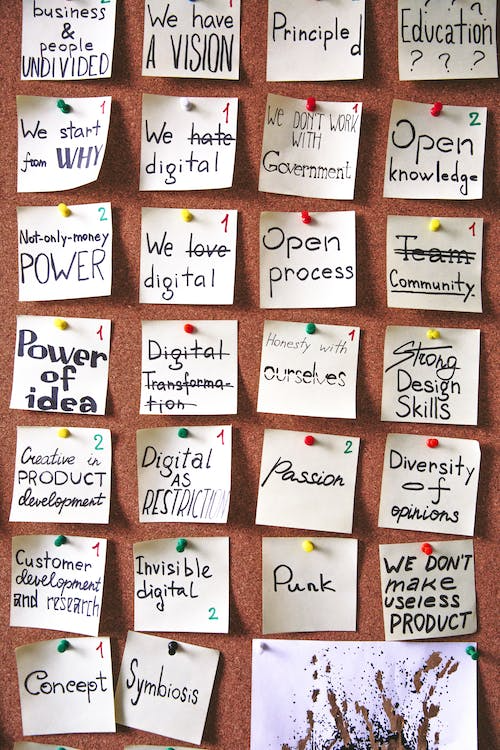
How to Start a Small Business from Scratch
Starting a small business is an exciting venture into entrepreneurship, but it becomes 20% harder due to supply chain disruptions in the Post-COVID world. Hence, It requires thoughtful planning and strategic thinking. Consider this guide your friendly GPS for navigating the direction of a profitable small business startup. Let’s break down the journey and simplify your path to establishing a startup.

Small Business Ideas: Turning Passion into Profit
This guide isn’t just about chasing dreams, it’s about building a financially rewarding future. Learn how to turn your skills and ideas into a stream of income, one step at a time. Now, here are 10 Exciting Ideas to Explore:
- Online Tutoring: Connect globally and share your knowledge in various subjects, or specialize in your expertise. It’s like bringing the classroom to the virtual world!
- Social Media Management: Leverage your social media savvy to help businesses shine online. Assist them in engaging their audience effectively and building a strong digital presence..
- Pet Grooming: Combine your love for animals with a grooming business. From haircuts to pet sitting, offer a paw-some service.
- Home Cleaning Services: Dive into the cleaning business. Make homes sparkle with services like dusting, vacuuming, and even deep cleaning.
- Event Planning: Unleash your creativity in event planning. Be it weddings or corporate events, turn gatherings into memorable experiences.
- Blogging: Share your passions through a blog by writing about what you love. Also you can monetize it through Ads, affiliates, or sponsored content.
- Graphic Design: Showcase your artistic side. Start a graphic design business, crafting visually stunning logos, cards, and brochures.
- Handmade Crafts: Turn your crafts into a business. Sell your creations online or at local markets and spread the joy of handmade goodness.
- Food Delivery: Bring delicious meals to people’s doors. Start a new business of food delivery and partner with local restaurants for a tasty venture.
- Fitness Coaching: Inspire others with your love for fitness. Offer coaching services, create workout plans, and guide clients toward healthier lives.

Tech-Savvy Ideas:
- App Development: You can design the next must-have app, catering to fitness, productivity, or a niche passion.
- Freelance Web Design: Leverage your coding skills to build sleek websites for local businesses or online clients.
- E-commerce Platform Creation: Turn your knowledge of online platforms into a business, helping brands set up and manage their e-commerce presence.
Writing and Communication:
- Content Marketing Consultant: Craft compelling content strategies for businesses, from blog posts to social media engagement.
- Freelance Writing: Showcase your storytelling skills by writing website copy, articles, or even ebooks.
- Grant Writing: Help non-profits and organizations secure funding by crafting winning grant proposals.
Consulting and Expertise:
- Virtual Assistant: Offer organizational and administrative support to busy professionals and entrepreneurs remotely.
- Business Coaching: Share your industry knowledge and guide aspiring entrepreneurs through launch and growth.
- Financial Consultant: Help individuals and small businesses navigate budgeting, investments, and financial planning.
Your entrepreneurial journey starts here – seize the opportunity!
Market Research
Our minds produce numerous business ideas each day, but not all are feasible for startups. The crucial step lies in discerning which ideas have practical potential. Without market research, these ideas lack validation and may prove worthless in the real business landscape. Market research for new businesses is the key to determining viability and ensuring that selected ideas align with market needs and demands. let’s explore some flexible research methods you can tailor to your unique idea:

DIY Research Methods
1.Customer Preferences:
Basic Surveys: Craft user-friendly surveys using tools like Google Forms or SurveyMonkey. Share them through social media, email, or community groups. Analyze responses for trends, preferences, and pain points. This reveals valuable insights into customer expectations and helps align your offerings with their needs.
Competitor Analysis: Become a detective! Identify key competitors, analyze their products, pricing, and marketing strategies. Assess customer reviews and feedback to find gaps and opportunities for differentiation. This knowledge empowers you to stand out and build a unique value proposition.
Online Insights: Leverage the power of the internet! Utilize search engines to track industry trends, explore Google Trends for keyword popularity, and dive into social media analytics to understand audience behavior. Web-based forums and communities offer additional goldmines of insights. Staying informed about trends and audience preferences ensures your business stays relevant and competitive.
2. Choose a Location Based on Local Demand
Imagine you’re planning a local bakery. Conduct surveys to understand preferred baked goods, analyze competitor offerings and customer feedback, and discover a demand for specialty cupcakes. Choose a location based on areas with a high demand for unique cupcakes. This approach ensures your offerings resonate with local preferences and maximizes your success potential.
3. Customize Research Questions for Your Ideas
Crafting research questions aligned with your business concept is crucial. For example a pet grooming service, inquire about pet owner preferences for services, pricing, and convenience. Use findings to tailor your offerings and set competitive pricing. Adapting your plan based on real customer feedback personalizes your approach and enhances your chances of success.
Fuel Your Success: Start Smart, Research Right. Act now for a thriving startup journey
Selecting Niche or Industry: Strategic Analysis for Business Success
1.Market Segmentation Analysis:
let’s break down this powerful tool:
- Define Your Target: Who are you aiming for? Clearly define your business objectives and target market.
- Segment and Conquer: Identify distinct market segments within your industry based on demographics, behaviors, and preferences. Think fitness enthusiasts, older adults, and beginners for your fitness app.
- Analyze and Tailor: Understand the needs, priorities, and pain points of each segment. This allows you to tailor your products, services, and marketing strategies to resonate with each group, maximizing the effectiveness of your efforts.
2. SWOT Analysis:
This tool helps you assess your internal strengths and weaknesses alongside external opportunities and threats:
- Internal Powerhouse: Evaluate your strengths (experienced team, innovative technology) and weaknesses (limited budget, niche market).
- External Landscape: Assess external opportunities (growing market, regulatory changes) and threats (new competitors, economic downturn).
- Strategize and Win: By understanding your strengths and weaknesses, you can leverage the opportunities and prepare for potential threats. This comprehensive analysis helps you formulate winning strategies and build a resilient business model.

3. Customer Persona Development:
Imagine your ideal customers come to life! Create detailed fictional profiles considering demographics, behaviors, and motivations. Use market research and customer feedback to refine these personas as you gain more insights.
- Target with Precision: Knowing your ideal customers inside and out allows you to personalize your marketing efforts, ensuring your message resonates with the right people.
- Meet Needs, Exceed Expectations: By understanding the unique needs and desires of your target audience, you can tailor your offerings to exceed their expectations, building lasting loyalty and fostering customer satisfaction.
Positioning Your Business for Victory:
Remember the fitness app scenario? Here’s how positioning plays out:
- Identify Gaps: Analyzing user segments revealed a gap for a user-friendly app tailored for individuals aged 60 and above.
- Claim Your Spot: Position your app as the solution for older adults seeking a convenient and effective way to stay active and healthy.
- Stand Out from the Crowd: By catering to an underserved niche and highlighting your unique value proposition, you establish yourself as the go-to solution for your target audience.
Refining Your Business Strategy:
The market is a dynamic beast! Continuously gather feedback from customers, adapt your offerings based on changing trends, and keep an eye on emerging technologies and evolving preferences. This agility allows you to stay ahead of the competition and build a resilient business model that thrives in the long run.
Building a Business plan
Whether you’re starting a small business, innovating with a startup, or taking your venture to the next level, a comprehensive business strategy is your roadmap to success.

Importance of a comprehensive business plan:
Guidance and Direction:
It provides a clear direction for the business. It outlines the company’s mission, vision, and long-term objectives.
Communication Tool: It serves as a communication tool, both for internal stakeholders (such as employees and management) and external stakeholders (such as investors and lenders).
Decision-making:
A well-thought-out business plan helps in making informed decisions. It provides a basis for evaluating opportunities and risks.
Attracting Investors:
Investors often require a comprehensive business plan before considering funding, which can attract them by showcasing the business’s potential and strategies for success..
Benefits Beyond Investors:
While attracting investors is pivotal, a well-crafted plan extends benefits beyond securing funds. It aids in obtaining loans, attracting partners, and aligning your team internally. It’s not just a document for outsiders; it’s a strategic tool for your entire organization.
Business planning for startups: Key components
- Executive Summary:
- A brief overview of the business, its mission, and key highlights.
- Summarizes the entire business strategy and provides a snapshot of the company’s goals and strategies.
- Business Description:
- Detailed information about the business, including its history, mission, vision, and values.
- Describes the nature of the business and the problem it solves.
- Market Analysis:
- Examination of the industry and market the business operates in.
- Analysis of competitors, target market, and potential for growth.
- Organization and Management:
- Details the structure of the company, including the organizational hierarchy and key personnel.
- Describes the roles and responsibilities of key team members.
- Services or Products:
- Provides information about the products or services offered by the business.
- Highlights unique selling points and competitive advantages.
- Marketing and Sales Strategy:
- Outlines the strategies for selling and promoting the products or services.
- Identifies target customers and details the sales channels.
- Funding Request:
- If applicable, specifies the amount of funding required and the purpose of the funds.
- Details how the funds will be used to support the business.
- Financial Projections:
- Presents forecasts for financial performance, including income statements, balance sheets, and cash flow statements.
- Helps investors and stakeholders understand the financial viability of the business.
- Appendix:
- Includes supplementary information such as charts, graphs, supporting documents, and any additional details that enhance the business strategy.
Airbnb’s Secret to Success: No Public Plan, No Problem
While Airbnb’s original business strategy from 2007 isn’t publicly available, there are several resources that tell the story of their success and highlight the role of their plan:
- Airbnb’s Blog: Look for posts under the “About Us” category, particularly “The 10-Year Overnight Story: How Airbnb Grew from Startup to Global Phenomenon.”
- Articles and Interviews: There are numerous articles and interviews with Airbnb co-founders Brian Chesky and Joe Gebbia discussing their early days and the importance of their Business strategy. Here are a few options:
- “The Airbnb Story: How Three Guys Disrupted the Travel Industry” on Inc.com:
- “From Air mattresses to Billionaires: Inside the Rise of Airbnb” on Forbes:
- “The Airbnb Founders on Building a Global Platform and Staying True to Their Roots” on Harvard Business Review:
- Books: Several books cover the history of Airbnb, including “Airbnb: The Book: Inside the Rise of the World’s Most Disruptive Hospitality Company” by Leigh Gallagher. These books often delve deeper into the company’s early vision and planning process.
Although the precise details of their initial strategy aren’t disclosed, these resources offer valuable insights into Airbnb’s early vision, strategic approach, and the pivotal role it played in their success story.
Before the Biz Plan: Know Yourself, Build a Blueprint
To tailor your business strategy effectively, consider taking a moment for self-reflection. What are your business goals? What challenges do you foresee? Integrate short quizzes or prompts throughout this guide to help you identify specific needs and focus areas within your business plan. This personal touch ensures that your plan is not just a template but a tailored strategy for your unique journey.
As you embark on creating your business strategy, consider utilizing resources, tools, or templates that align with your specific needs. Websites like Google Trends and Survey Monkey offer valuable insights and customizable templates to kickstart your planning process. Remember, the most effective plans are not only well-structured but also adaptable to the dynamic nature of business.
Legal Requirements for Starting a Business
Choose a Business Structure
- Explore different legal structures, such as sole proprietorship, partnership, limited liability company and corporation. For instance, a sole proprietorship means you are the only owner, while a corporation offers separate legal status.
- Understand the specific rules and responsibilities associated with each legal structure. For example, a corporation might require regular shareholder meetings and detailed record-keeping.

Registering the Business:
- Choose a legal business structure that aligns with your business goals and structure preferences.
- Complete the official business registration process with the relevant government authorities. This may involve submitting forms, paying fees, and providing essential details.
- Work with legal professionals or digital platforms specializing in business registration to streamline the process and ensure accuracy.
Obtaining Necessary Licenses and Permits:
- Identify the specific licenses or permits required for your business based on its nature and location. For instance, a restaurant may need health permits and a food handler’s license.
- Ensure strict compliance with all laws and regulations related to your industry. Regularly check for updates to stay informed about any changes.
- Obtain official permissions for specific activities, such as selling certain products or operating in designated areas. Seek guidance from local government offices or industry associations to navigate this process efficiently.
Financial Management in Entrepreneurship:
Budgeting for Startup Costs:
Launcing a new business involves understanding and estimating various costs. To tailor this process to your specific industry or business model:
- Industry-Specific Resources: Explore industry-specific guides or resources that provide insights into common startup costs. This can help you make more accurate budget estimates based on the unique requirements of your business.
Funding Options for Startups:
Entrepreneurs need to explore funding opportunities that align with their business goals. Consider introducing the concept of financial forecasting:
1. Self-funding:
- Personal Savings: Use your own savings to kickstart your business. This method provides full control and flexibility.
- Bootstrapping: Run your business with minimal external help, focusing on generating revenue to sustain and grow.
2. Loans and Grants:
- Bank Loans: Consider traditional bank loans, understanding their terms and interest rates.
- Government Grants: Explore grants tailored to specific business types or initiatives.
3. Investors and Crowdfunding:
- Angel Investors: Seek investments from individuals in exchange for a share of your business.
- Venture Capital: Approach venture capitalists for funding, particularly if your business has high growth potential.
- Crowdfunding Platforms: Utilize platforms where a community supports your project with small contributions.
- To address financial risks, consider:
- Contingency Fund and Risk Assessment: Develop a contingency fund to tackle unforeseen challenges. Additionally, conduct a risk assessment using methods like Indiegogo or GoFundMe to identify and plan for potential financial pitfalls.
- Example Industry Resources: Explore National Venture Capital Association (NVCA) for retail businesses orAngel Capital Association (ACA)] for manufacturing to understand industry-specific costs better.
- Financial Forecasting Tools: Consider using tools like Canva or Slidebeanto create financial projections and make informed funding decisions.
- Risk Assessment Methods: Explore methods such as SWOT analysis or scenario planning to assess and mitigate potential risks.
- Visualizing Costs: A visual representation of typical startup costs across different industries can be found in the attached chart.
Carefully assess each funding option based on your business’s needs, growth strategy, and your comfort level with relinquishing control or taking on debt. This comprehensive financial approach will help ensure the stability and success of your entrepreneurial venture.
Marketing Strategies for Startups:
Building a Brand Identity:
Creating a distinctive brand identity is crucial for startups to stand out in the market.
Logo and Design:
Design an eye-catching logo by using special colors and shapes because your logo will represent your business. It will draw a picture of your business in the customer’s mind whenever they see it, reminding them about your business.
Why logo and design Important in business?
- A unique logo helps people remember your business.
- Design elements create a special look and feel for your brand.
- Together, they make your business easily recognizable and memorable.
Brand Messaging:
- Develop a clear and compelling message that communicates your brand’s values and mission.
Consistency:
- Ensure consistency in visuals and messaging across all platforms for a cohesive brand identity.
Developing a Marketing Plan:
Crafting a comprehensive marketing plan involves strategic thinking and a multi-faceted approach.
Online Strategies:
Online strategies leverage the power of the internet to reach a broader audience.
- Website Development: Create an engaging website that reflects your brand and provides essential information about your products or services.
- Search Engine Optimization (SEO): Optimize your online content to enhance visibility on search engines and attract organic traffic.
- Content Marketing: Develop relevant and valuable content to establish authority in your industry and engage your target audience.
Offline Strategies:
Offline strategies focus on traditional sales channels to connect with local audiences.
- Print Media: Utilize printed materials such as brochures, flyers, or newspaper ads to reach potential customers in your community.
- Networking Events: Attend local events, conferences, or trade shows to establish connections and promote your startup in person.
- Direct Mail: Send targeted promotional materials via mail to specific geographical areas or demographics.
Utilizing Social Media and Digital Platforms:
Social media and digital platforms play a pivotal role in reaching a vast audience and building brand awareness.
- Social Media Marketing: Engage with your audience on digital platforms like Facebook, Tiktok, Instagram, Whatsapp, and X. Create compelling content and utilize paid advertising to expand your reach.
- Email Marketing: Develop targeted email campaigns to nurture leads and keep your audience informed about your products or services.
- Digital Advertising: Leverage online advertising channels, such as Google Ads or social media ads, to reach a specific demographic and drive traffic to your website.
Other Strategies
Industry-Specific :
Marketing strategies need to be as diverse as the industries they serve. What works for a tech startup might not resonate with a local bakery.
Don’t waste money, make money:
- Plan your budget: Define goals, map routes, fuel wisely.
- Track your ROI: Google Analytics is your pit crew, showing what works and what doesn’t.
- Data-driven decisions: Ditch gut feelings, invest in proven winners, optimize for growth.
- Be flexible: Adapt to market changes, seize new opportunities.
“Marketing success happens when every penny counts and every click drives you forward.”
Tools and Resouces
- Websites: Wix & Squarespace (easy drag-and-drop), WordPress (powerful customization).
- SEO: Moz & SEMrush (keyword research, competitor analysis), Google Search Console (free site insights).
- Social Media: Hootsuite & Buffer (schedule & publish across platforms), Sprout Social (deep analytics & ROI).
- Email Marketing: Mailchimp & Sendinblue (create campaigns, manage lists), ActiveCampaign (automation & personalization).
Pro Tip: Integrate your tools for ultimate marketing workflow
Take Charge of Your Startup’s Success Today!
Elevate your brand, captivate your audience, and boost your business with proven marketing strategies. Refine your brand, launch impactful campaigns, and witness growth. Start now and conquer tomorrow!
Steps to Launch a Successful Business:
Forming a Launch Team:
Building a capable and motivated launch team is a critical step in ensuring a successful business launch.
- Identify Key Roles:
- Define the key roles needed for the launch team, such as marketing, operations, finance, and sales.
- Seek individuals with complementary skills and a shared passion for the business.
- Recruitment and Onboarding:
- Conduct a thorough recruitment process to select team members who align with the company’s values and goals.
- Implement an effective onboarding program to integrate new members seamlessly into the team.
Executing the Business Plan:
Implementing the business plan is the next crucial step in turning your vision into a reality.
- Strategic Implementation:
- Break down the business plan into actionable tasks and assign responsibilities to team members.
- Ensure that the timeline and milestones align with the overall business objectives.
- Resource Allocation:
- Allocate resources efficiently, considering both human resources and budgetary constraints.
- Monitor resource utilization to prevent bottlenecks and ensure a smooth execution process.
Monitoring and Adapting to Market Feedback:
Continuous monitoring and adaptation to market feedback are essential for staying agile and responsive.
- Feedback Collection:
- Establish channels for collecting feedback from customers, stakeholders, and the market.
- Leverage surveys, customer reviews, and analytics tools to gather valuable insights.
- Data Analysis and Adaptation:
- Analyze collected data to identify trends, strengths, and areas for improvement.
- Adapt business strategies, products, or services based on the analyzed feedback to meet market demands.
Remember:
- A dedicated team: Surround yourself with talented and passionate individuals who believe in your vision.
- A well-defined plan: It serves as your roadmap, guiding your decisions and actions.
- Agility and adaptability: Be prepared to pivot and adjust your approach based on market feedback.
By following these steps, entrepreneurs can set a solid foundation for the growth and sustainability of their ventures.
Entrepreneurial Journey
Imagine being an adventurer on a big journey, like climbing a really highestl mountain. Along the way, you’ll face challenges, but guess what? Those challenges are like stepping stones to reaching the very top!
Embracing challenges and setbacks
Facing challenges is like dancing in the rain. Sara Blakely, founder of Spanx, revolutionized shapewear. Starting with $5,000, she overcame rejections, promoting her product door-to-door and through clever sales strategy. Her appearance on Oprah catapulted Spanx’s success. Now a billionaire, Blakely donates to charities. Despite challenges, she’s expanding Spanx globally, proving resilience and entrepreneurial spirit.. Learn from Sara Blakely: challenges are like puzzles waiting to be solved!
Learning from failures and successes
Occasionally, plans don’t unfold as expected, and that’s perfectly acceptable! Imagine Jessica Alba, founder of The Honest Company, She founded the company a decade ago, starting with baby products. Since then, the company’s portfolio has expanded to include makeup, sunscreen and cleaning supplies . Now it’s super popular. Remember Jessica Alba: mistakes can lead to awesome discoveries!
Staying adaptable and innovative
Being adaptable is like changing colors in a magical forest. Imagine Gary Vaynerchuk, a true entrepreneur, turned a local liquor store into a pioneering e-commerce platform. Co-founder of VaynerMedia, he scaled businesses, invested in tech giants, and authored bestsellers. Gary’s influential digital presence and strategic ventures define modern entrepreneurship. His ambition? To buy the New York Jets. Remember Gary Vaynerchuk: change can be like adding bright colors to your adventure!
You don’t need to wait for the perfect moment – grab your headlamp and start climbing your Everest of opportunities!
This week, challenge yourself to find one obstacle and turn it into a cool opportunity. Share your story and what you learn; you might just inspire others to conquer their challenges too.
Keep in mind, the best view comes after the toughest climb. So, lace up those boots, fellow adventurer, and let’s redefine success together, one challenge at a time
In conclusion, starting a small business post-COVID presents challenges, especially with supply chain disruptions. This guide serves as a roadmap for entrepreneurs, emphasizing strategic planning.
The guide explores diverse business ideas, from online tutoring to tech-savvy ventures. Market research, strategic analysis, and customer persona development are crucial for success.
A comprehensive business plan, though not necessarily public, is vital. Legal requirements, registration, and financial management are essential considerations.
Effective marketing, both online and offline, is key. Steps for a successful launch include building a capable team, executing the plan, and adapting to market feedback.
The entrepreneurial journey is likened to an adventure, with challenges viewed as stepping stones. Case studies of successful entrepreneurs underscore the importance of resilience, learning from failures, and innovation.
In essence, the guide encourages entrepreneurs to embark on their journey, turn obstacles into opportunities, and redefine success one challenge at a time.







